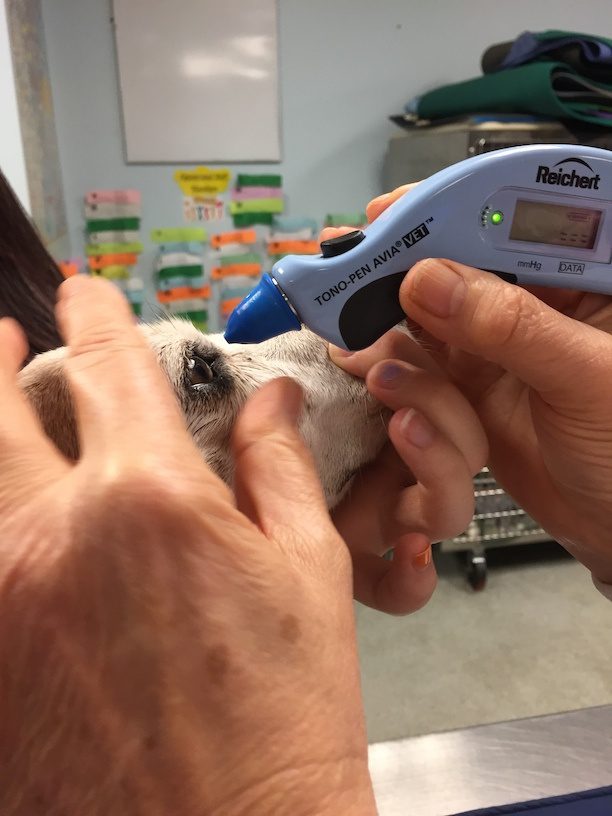by Jess Franklin, DVM
Binnie is a beagle who came to see me in the spring of 2017 because she acted as if she had a headache. She was sleeping in odd places, hiding, and cowering when moved to her crate. Her eyes seemed normal with no redness, no changes to the pupils, and she seemed to be able to see.
Because beagles are one of the most commonly seen breeds with genetic tendency to glaucoma, we tested the eye pressure in both eyes using a device called a tonometer which measures intraocular pressure, or IOP. Normal is 10-20mm Hg, and anything higher than 25mm is cause for concern; the IOP in both eyes was over 30mm on that day. Because vision is so important, she is now a shared patient with a veterinary ophthalmologist.

This is Binnie getting her eye pressure measured. We put a local numbing eye drop in the eye, and then press the Tono-Pen to the cornea. For people, eye pressure is usually measured during an eye exam with a puff of air.
More than 1 year later, Binnie takes 3 daily eye medications and her eye pressure is monitored, but she can still see.
Breeds where glaucoma can be primary (usually genetic and not related to injury to the eye) include beagles, Norwegian Elkhounds, and Petit Basset Griffon Vendeen. This group tends to open angle glaucoma, have a slower onset of signs, and a perhaps better chance to retain vision for longer periods. Genetic testing has so far pointed to specific mutations for beagles. In contrast, Bassetts, Flat-Coated Retrievers, Springer Spaniels, Cocker Spaniels and Huskies tend toward a faster loss of vision with closed angle glaucoma. However, any dog can have glaucoma—I have recently helped manage a Shiba Inu and a Labrador Retriever.
Signs that make us suspect glaucoma include red eyes, enlargement to the eye globe, dilated pupils, blindness, and blue change to the cornea. Binnie was lucky in having testing while she still had vision because her family knew something was wrong. Most dogs do not show any signs of early glaucoma except elevated eye pressure during the best time to start to manage the disease, which usually mean that it goes undiagnosed until it’s too late. A dog that is seen after vision loss is less likely to get vision to return.
We start medications and may get improvement if the drugs are started soon after the onset of signs, and we monitor eye pressures after starting medications to keep the pressure down. If vision is gone, then the goal is to maintain pain-free eyes that do not enlarge or luxate lenses or damage the cornea. Sometimes the best course of action is to remove the affected eye(s) to prevent further injury and pain, as was the case with Lacie and Yogert. A halo harness, such as Muffin’s Halo, can be worn to help a blind or vision-impaired dog get around without hurting itself.
In the same way that older cats with thyroid or kidney issues need blood pressure monitoring, older dogs should have eye pressure monitoring. This can be part of our normal annual exam. If your dog getting up in years or is a breed that’s genetically predisposed to glaucoma, talk to your veterinarian about having his eyes checked.
Recent Posts
About Us
Ann Arbor Animal Hospital is a locally-owned animal hospital operating for over 90 years in Ann Arbor, MI.
